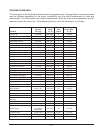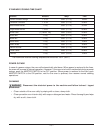
– 3 –
INSTALLATION
UNPACKING
Immediately after unpacking the oven, check for possible shipping damage. If the oven is found to be
damaged, save the packaging material and contact the carrier within 15 days of delivery.
Prior to installation, verify that the electrical service agrees with the specifications on the oven data
plate, located on the inside of the top front cover.
Do not use the doors or their handles to lift the oven.
LOCATION
The installation location must allow adequate clearances for servicing and proper operation. There
must be 18" (457 mm) of clearance on the right side of the oven from any open flame.
INSTALLATION CODES AND STANDARDS
In the United States, install the oven in accordance with:
1. State and local codes.
2. National Electrical Code, ANSI/NFPA-70 (latest edition). Copies may be obtained from The National Fire
Protection Association, Batterymarch Park, Quincy, MA 02169-7471.
3. NFPA Standard #96,
Vapor Removal from Cooking Equipment
(latest edition). Copies may be obtained
from The National Fire Protection Association, Batterymarch Park, Quincy, MA 02169-7471.
In Canada:
1. Local codes.
2. CSA C22.1 Canadian Electrical Code (latest edition).
3. CSA C22.2 No. 109 Commercial Cooking Equipment (latest edition).
The above are available from the Canadian Standard Association, 5060 Spectrum Way, Suite 100,
Mississauga, Ontario, Canada L4W 5N6.
INSTALLING BASIC OVEN
The oven must be installed on legs or mounted on a modular stand. Installations on concrete bases or
other supports restricting air circulation underneath the oven is not advisable and may void the
warranty. If using the modular stand, set the oven on the stand after unpacking.
Assembling the Legs to the Oven
The legs must be installed on the bottom of the oven. Gently position the oven on its left side, taking care
not to scratch or damage the oven.
Attach each of the four leg assemblies to the bottom of the oven with the 24 bolts and lockwashers (six per
leg). Carefully raise the oven to its normal position.














